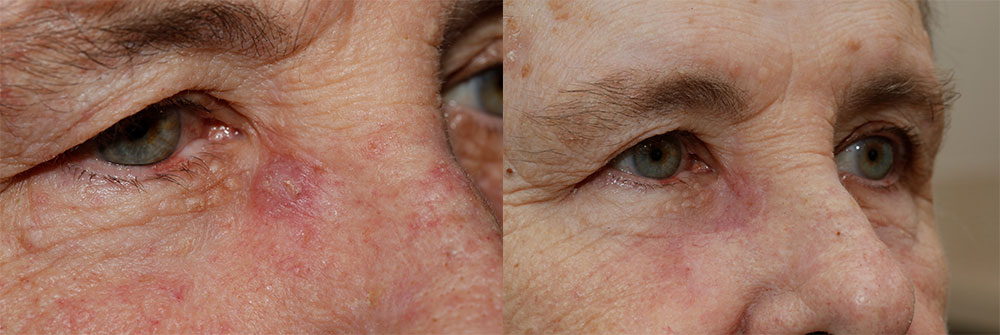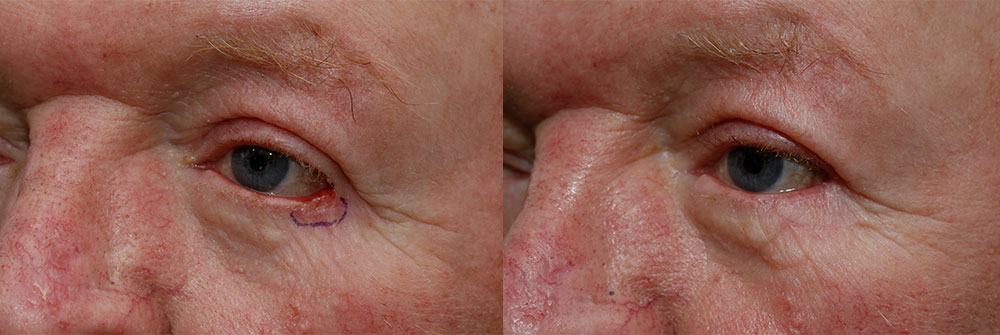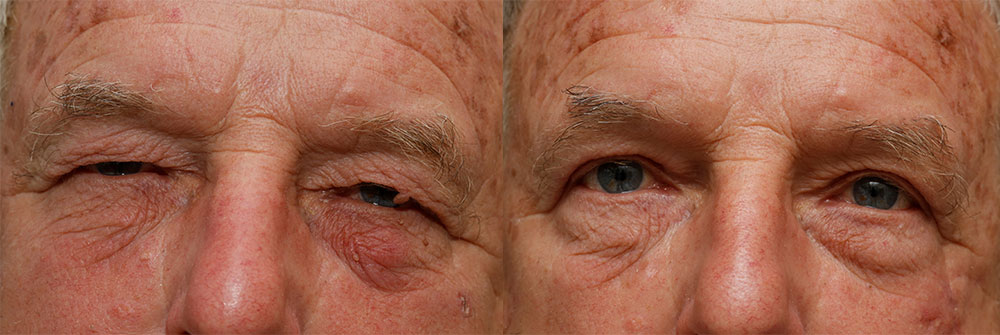
Oasis Eye Face and Skin | Ashland, Medford, Grants Pass, Oregon
The skin around the eye is very thin, and the fact that it’s constantly exposed to sun damage makes it susceptible to skin cancer. Eyelid skin cancer mostly occurs on the lower eyelid in the form of basal cell carcinoma. Skin cancer, however, can develop anywhere on the eyelid margins or corners of the eye. Squamous cell carcinoma and melanoma can also appear, but these types of cancer are less common. Since we rely on this skin to protect the eyes, it is important to have an eye expert on your side. Dr. Vivian Schiedler is a highly skilled eyelid plastic surgeon whose extensive training and experience can be used to determine whether the eyelid lesion is cancerous. Together with her team at Oasis Eye Face and Skin, Dr. Schiedler will work with you to devise a treatment plan that improves your chances of restoring your eye health and function.
Risk Factors for Developing Eyelid Skin Cancer
It’s important to protect your eyes when stepping outside into the sun’s rays. A big hat and sunglasses, as well as sunscreen, can provide much-needed protection. Many people focus mainly on the larger areas of exposed skin and often forget about the skin around the eyes. Sun exposure is one of many factors that can predispose you to skin cancer. Other culprits include:
- Multiple sunburns in childhood
- Excessive UV exposure, from things like tanning beds
- Radiation
- Burns
- Scars
- A family history of skin cancer
- Smoking
Types of Eyelid Skin Cancer
The most common type of skin cancer is basal cell carcinoma. It accounts for 90% of all diagnosed skin cancer. Squamous cell carcinoma is a less common cause of skin cancer found on the eyelids. It is very rare for either of these skin cancers to metastasize. They typically grow slowly, but given enough time unchecked they can destroy tissues and nearby structures. Skin cancer can destroy the eyelashes and irritate the eye if it is constantly rubbing against it. Other patients present with a tumor that grows into the tear drain or even into the eye socket. In extreme cases, skin cancer may be impossible to remove if it has grown into deeper tissues. Fortunately, basal cell and squamous cell carcinoma are highly treatable, and the prognosis is good when the lesion is found early.
Catching and treating skin cancer early greatly improves the outcome. It is a good idea to have a specialist check any mole that you feel has changed over the last year. Unfortunately, most skin cancers are ignored because they present with few symptoms. However, here are a few things to keep an eye out for:
- Basal cell carcinoma – a pearly shiny lump that keeps growing slowly
- Squamous cell carcinoma – a scaly red flaky patch of skin that won’t heal
Melanoma is a more serious form of skin cancer that can spread to other organs and be lethal. Due to the aggressive nature of this cancer, it is important to find and treat melanoma immediately. Luckily melanoma accounts for about 4% of all skin cancer cases, but its incidence is on the rise. It is important for people with a family history or significant sun exposure to be screened regularly, particularly if they have more than 20 moles on their body. Following the ABCDs can give you an idea as to whether a mole is suspicious: Asymmetry, Borders getting fuzzy, Color inequality, and Diameter larger than a pencil eraser.
Treatments Options for Eyelid Skin Cancer
It is important to consider two things when considering eyelid skin cancer treatments: the complete removal of the cancer and eyelid reconstruction. Since the eyelid area is so small, it is essential to start with a biopsy to confirm the diagnosis.
Once confirmed, Dr. Schiedler may recommend Mohs surgery. Mohs surgery aims to preserve as much tissue while completely excising the skin cancer. This allows for the best chance at full recovery and an optimal cosmetic outcome.
During a Mohs surgery, a layer of the skin is removed and checked under a microscope to see if the borders are free of cancerous tissue. If it isn’t, this process is repeated while going deeper until an all-clear sample is taken. Dr. Schiedler can then repair the eyelid the same day or next day. There are other options for skin cancer removal, and Dr. Schiedler will go over all the options with you.
Most patients are naturally fearful of disfigurement. Eyelid cancer surgeon Dr. Schiedler is highly skilled at reconstructive surgery of the eyelid and understands the importance of well-functioning eyelids. She strives to repair each defect with the utmost attention to detail in order to obtain the most natural and comfortable results.
Results and Recovery from Eyelid Reconstruction
Some types of eyelid repair, such as skin grafts, require a patch to be worn over the eye for a week after surgery. However, most eyelid skin cancer reconstructions do not need a patch. Patients will usually go home the same day and are advised to apply antibiotic ointment to the stitches. Avoiding strenuous exercise for a week is also a common recommendation.
The vast majority of skin cancers on the eyelid can be cured surgically. It is best to catch these skin cancers early, as the repair becomes more difficult the larger they are. As an ophthalmologist, Dr. Schiedler has the advantage of using a slit lamp to examine the eye and eyelid. This allows her to see small growths on the skin and eye surface and determine if a biopsy is advisable. In cases that present with very tiny lesions, a simple biopsy may be curative.
Dr. Schiedler uses her experience as a trained ophthalmologist and oculofacial plastic surgeon to develop the most appropriate treatment plans. If you are concerned about possible eyelid skin cancer or any eye-related condition, contact Oasis Eye Face and Skin at (541) 708-6393 and schedule a personal consultation! Skin cancer is not a disease you want to put aside, please call today.






